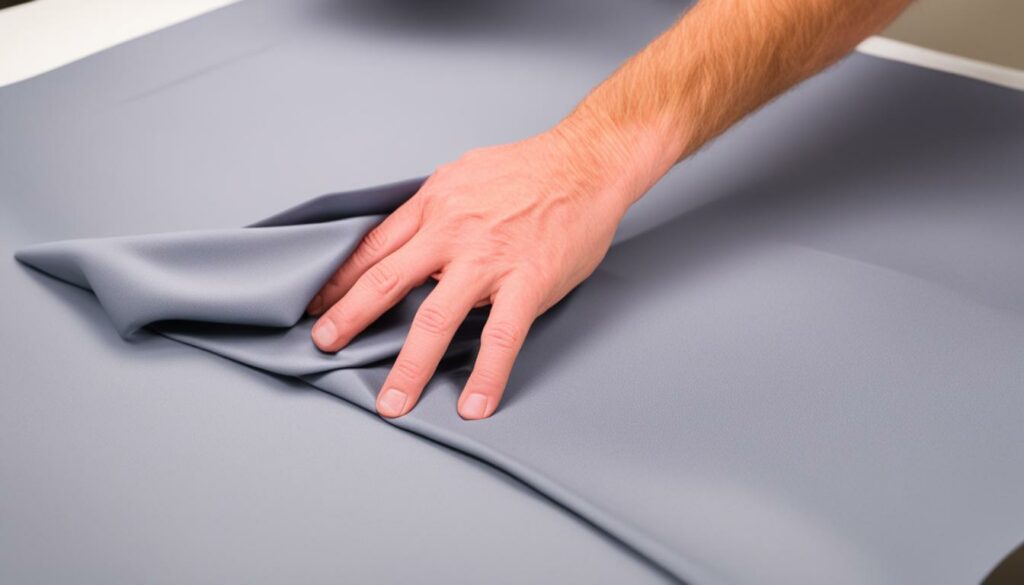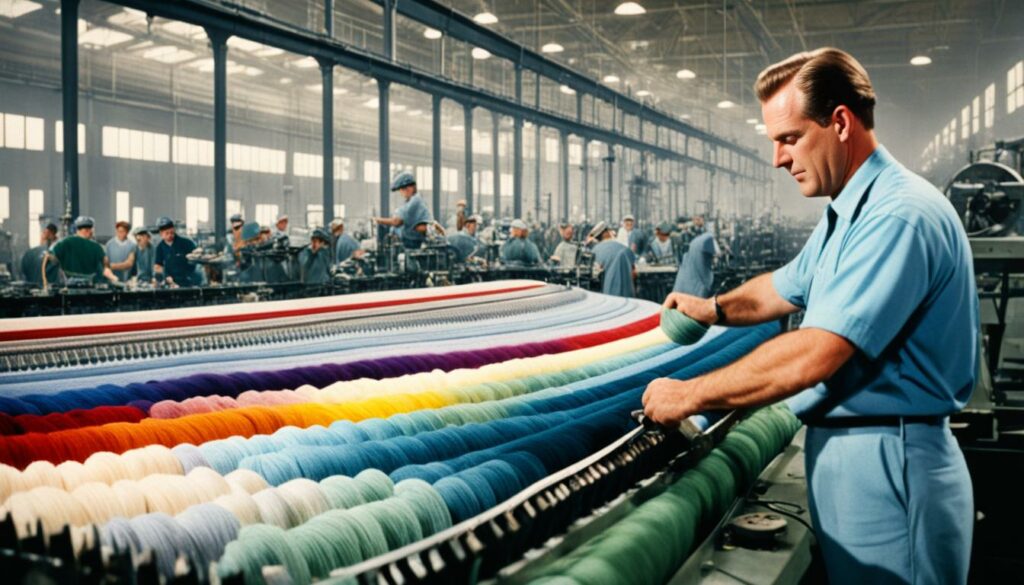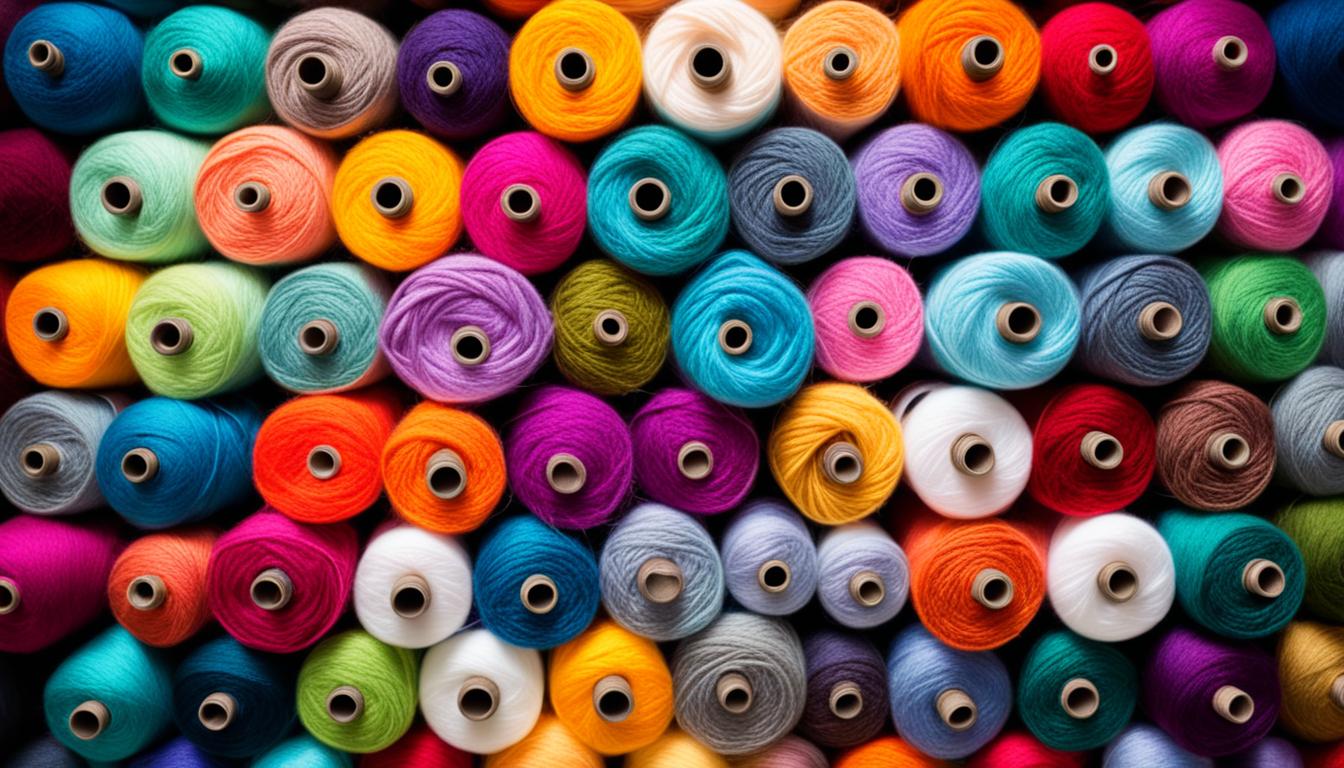Have you ever thought about whether polyester yarn stretches like other fabrics? How does it measure up against materials like spandex or elastane? Let’s take a closer look at polyester and examine its elasticity, durability, and stretchiness.
Polyester is a versatile synthetic fabric that offers resistance to wrinkles and shrinking, making it a popular choice in the textile industry. But when it comes to stretch, does polyester hold up? The answer lies in understanding the properties and factors that influence the stretchiness of polyester yarn.
Key Takeaways:
- Polyester yarn has some degree of stretch, but its elasticity is influenced by factors such as material type, weaving method, and fabric thickness.
- Polyester blends with other fibers can create more stretchy fabrics, making them ideal for athletic wear and fitted clothing.
- Knit polyester fabrics tend to be more stretchy than woven fabrics made of polyester.
- Polyester’s easy care and maintenance, resistance to wrinkles and stains, and durability make it a versatile fabric.
- Understanding the stretchability of polyester can help you choose the right fabric for your clothing and home decor needs.
Polyester Fabric Production: Raw Materials and Recycling
In the world of textiles, polyester fabric stands out as a popular choice for its durability, affordability, and versatility. Its production involves two main methods: manufacturing from raw materials and recycling plastic. Let’s explore the processes, benefits, and environmental impact of these production methods.
Producing Polyester from Raw Materials
Polyester fabric can be created from raw materials, which typically include ethylene glycol and dimethyl terephthalate. These materials undergo a chemical reaction to form polymers, which are then extruded into polyester yarn. This yarn serves as the foundation for various polyester-based products, including clothing, bedding, curtains, and upholstery.
Raw materials, such as ethylene glycol and dimethyl terephthalate, are key components in the production of polyester fabric.
This method of producing polyester from raw materials offers several advantages. It ensures consistent quality, as the production process can be tightly controlled. Additionally, it allows for the creation of a wide range of polyester fabrics with different textures, thicknesses, and finishes to cater to diverse consumer preferences.
Creating Polyester from Recycled Plastic
The alternative method of polyester fabric production involves recycling plastic. This process begins with the collection and shredding of plastic waste, typically derived from bottles or containers. The shredded plastic is then sorted, cleaned, and dried to remove any impurities. Next, the plastic undergoes a melting and extrusion process similar to the traditional production method, resulting in polyester yarn.
Recycling plastic to make polyester fabric offers environmental benefits by reducing waste and conserving resources. It gives new life to discarded plastic, promoting a circular economy and minimizing the reliance on virgin materials. This approach aligns with sustainable practices and contributes to the overall reduction of plastic pollution.
The recycling process transforms plastic waste into durable and wrinkle-resistant polyester fabric.
Comparing the Methods
| Production Method | Advantages | Considerations |
|---|---|---|
| Raw Materials | – Consistent quality- Wide variety of fabric options | – Reliance on virgin materials- Energy-intensive process |
| Recycling Plastic | – Environmental sustainability- Waste reduction- Resource conservation | – Need for effective recycling infrastructure- Higher risk of impurities in the recycled material |
The Future of Polyester Fabric Production
The textile industry is increasingly focusing on sustainable manufacturing practices and exploring innovative solutions. Both the production methods—using raw materials and recycling plastic—have their merits and contribute to the availability of high-quality polyester fabric. As advancements in recycling technologies continue, the industry can further optimize the recycling process and increase the use of recycled plastics in polyester production.
Stretchiness of Polyester Fabric
While polyester fabric does have some stretch, it’s not as stretchy as fabrics like spandex or elastane. The stretchiness of polyester fabric is influenced by various factors such as the type of material used, the weaving method, and the fabric thickness.
Polyester blend fabrics, which combine polyester with other fibers like spandex, can be more stretchy compared to 100% pure polyester fabrics. The addition of spandex or elastane enhances the stretchability of the fabric, making it suitable for athletic wear and garments that require flexibility.
Knit polyester fabrics tend to be more stretchy than woven fabrics made of polyester. The knitting technique creates loops in the fabric structure, allowing for greater stretch and movement. On the other hand, woven polyester fabrics have a more tightly woven construction, limiting their stretchability.
The thickness of the polyester fabric can also affect its stretchiness. Thicker polyester fabrics tend to be less stretchy compared to thinner fabrics. This is because the additional layers of fibers in thicker fabrics reduce the room for stretching and movement.
Factors Affecting the Stretch of Polyester Fabric:
- Type of material used
- Weaving method
- Fabric thickness
Understanding the stretchiness of polyester fabric and the factors that affect it is essential for making informed decisions when choosing fabrics for different applications. Whether it’s for athletic wear, everyday clothing, or home textiles, considering the stretchability of polyester fabric can help ensure a comfortable and well-fitting end product.
Sources:
– “Polyester vs. Spandex: What’s the Difference?” by The Critter Co. Retrieved from https://www.thecritterco.com/
– “Understanding Fabrics: Polyester” by Fibers.com. Retrieved from https://www.fibers.com/
Blends of Polyester with Other Fabrics
Polyester is a versatile fabric that can be combined with various materials to create unique blends with different properties and applications. These polyester blends offer a range of benefits, from enhanced durability and stretchability to improved comfort and breathability. Let’s explore some popular blends of polyester with other fabrics:
Polyester-Cotton Blend
A polyester-cotton blend combines the durability of polyester with the softness and breathability of cotton. This blend is commonly used in everyday wear, including t-shirts, bed linens, and shirts. It offers the best of both worlds, providing a comfortable fabric that is easy to care for and retains its shape well.
Polyester-Rayon Blend
A polyester-rayon blend creates a soft and comfortable fabric with a subtle shine. This blend is often used in dresses, blouses, and formal wear, offering a luxurious feel and drape. The blend combines the strength and wrinkle resistance of polyester with the smooth texture and breathability of rayon.
Polyester-Spandex Blend
A polyester-spandex or elastane blend offers significant stretchability, making it perfect for sportswear, yoga pants, or fitted dresses. The addition of spandex provides excellent elasticity, ensuring that the fabric retains its shape and allows for freedom of movement.
Polyester-Wool Blend
A polyester-wool blend is a popular choice for suits and winter wear. It combines the warmth and softness of wool with the strength, durability, and wrinkle resistance of polyester. This blend offers a balance of comfort and functionality, making it ideal for cold weather garments that require both insulation and resilience.
Polyester-Linen Blend
A polyester-linen blend provides lightweight comfort and reduced wrinkling. This blend is commonly used in summer clothing and home textiles. It combines the breathability and natural texture of linen with the easy-care properties and wrinkle resistance of polyester.
By blending polyester with other fabrics, manufacturers can create fabrics that cater to specific needs and preferences. Whether it’s enhancing durability, adding stretch, or improving comfort, polyester blends offer versatile options for a wide range of applications.
Stretching Polyester Garments
If you find that your polyester garments have become less comfortable or no longer fit as well as they used to, don’t worry, there are ways to stretch them out and restore their original shape. Whether it’s a polyester shirt, hoodie, or any other polyester clothing item, here are some simple methods to consider:
- Lay the garment on a flat surface and gently pull it in all directions. This helps to stretch the fibers and improve the overall fit. Be cautious not to pull too hard as it may damage the fabric.
- Consider using a steamer to relax the polyester fiber and make it more stretchable. The steam helps to loosen the fibers, allowing for easier stretching. Remember to follow the steamer instructions and avoid direct contact with the fabric.
- Another option is to use an iron on low heat with a damp cloth. Place the damp cloth over the polyester garment and carefully iron over it. The combination of heat and moisture can help relax the fibers and make them more pliable for stretching. Again, it’s essential to use low heat to prevent any damage.
It’s important to note that not all polyester garments can be stretched without consequences. To ensure the safety of your clothing item, always check the care label for specific instructions. If the label advises against stretching or you are unsure, it’s best to avoid stretching altogether to prevent any potential damage to the fabric.

Remember, stretching polyester garments should be approached with caution to preserve their integrity and fit. By following these simple techniques and adhering to care instructions, you can maintain the comfort and longevity of your favorite polyester clothing items.
Caring for Polyester Fabric
Polyester fabric is a popular choice for its durability, easy care, and versatility. To ensure that your polyester fabric maintains its stretchiness and longevity, it’s important to follow proper care instructions. Here are some tips for caring for your polyester fabric:
- Machine Washing: Polyester fabric can be safely machine washed. Use a gentle cycle and cold or warm water to prevent heat damage or excessive shrinkage. Avoid using hot water, as it can cause the fabric to lose its stretchiness. Use a mild detergent that is suitable for synthetic fabrics.
- Drying: Polyester fabric can be tumble dried on low heat or air-dried. Avoid high heat, as it can cause the fabric to shrink or lose its stretch. Remove the fabric from the dryer while it is still slightly damp to minimize wrinkling.
- Stain Removal: Polyester fabric is resistant to stains due to its non-porous nature. However, if a stain occurs, it’s important to treat it promptly. Blot the stain with a clean cloth or sponge, then apply a mild detergent or stain remover. Gently rub the fabric in a circular motion, then rinse thoroughly with water.
- Ironing: Polyester fabric is known for its resistance to wrinkles. However, if ironing is necessary, use a low heat setting and iron the fabric while it is slightly damp. Place a damp cloth between the iron and the fabric to protect it from direct heat.
In addition to following these care instructions, it is always a good idea to check the care label on your garment for specific recommendations. Proper care ensures that your polyester fabric stays stretchy, maintains its shape, and continues to look its best.
“Proper care ensures that your polyester fabric stays stretchy, maintains its shape, and continues to look its best.”

| Do’s | Don’ts |
|---|---|
| Machine wash on a gentle cycle with mild detergent | Use hot water (stick to cold or warm water) |
| Tumble dry on low heat or air-dry | Expose to high heat during drying |
| Blot and treat stains promptly | Use harsh chemicals or bleach on stains |
| Iron on low heat with a damp cloth | Iron on high heat directly on the fabric |
The History and Production of Polyester
Polyester, a synthetic fabric known for its cost-effectiveness, durability, and versatility, has a rich history dating back to its discovery in 1929 by American scientist Wallace H. Carothers. However, it wasn’t until the 1970s that polyester gained widespread popularity in various industries. Let’s explore the fascinating history of polyester and its production process.
Polyester can be produced using two methods: from raw materials or through the recycling of plastic. When manufacturing polyester from scratch, the process starts by reacting ethylene glycol with dimethyl terephthalate, resulting in the creation of polymers. These polymers are then extruded into polyester yarn, which can be further processed to create various fabrics with different textures, thicknesses, and finishes.

The production of polyester from recycled plastic follows a similar process. It involves shredding plastic, sorting it, cleaning, drying, melting, and extruding it into polyester yarn. This sustainable production method helps reduce waste and environmental impact, making polyester an eco-friendly fabric choice.
With its production process refined over the years, polyester has become a widely used fabric in numerous applications. From clothing and home textiles to industrial products, polyester offers durability, versatility, and affordability.
The Advantages of Polyester Production
Polyester’s production process has several advantages:
- Cost-effectiveness: Polyester production is relatively inexpensive, making it a cost-effective fabric option for both manufacturers and consumers.
- Durability: Polyester fabrics are known for their strength and resistance to wear and tear, ensuring longevity and durability.
- Versatility: The extrusion process allows the production of polyester yarn with different characteristics, making it suitable for a wide range of applications.
- Eco-friendly options: Polyester can be produced from recycled plastic, contributing to a more sustainable textile industry.
Polyester’s production methods have evolved over time to meet the growing demand for this versatile fabric. Whether manufactured from raw materials or recycled plastic, polyester continues to dominate the textile industry with its wide range of uses and benefits.
| Advantages of Polyester Production | Production Process |
|---|---|
| Cost-effectiveness | Reacting ethylene glycol with dimethyl terephthalate to create polymers, which are extruded into polyester yarn. |
| Durability | Extruding recycled plastic into polyester yarn, offering a sustainable production method. |
| Versatility | Creating polyester fabrics with various textures, thicknesses, and finishes. |
| Eco-friendly options | Shredding, sorting, cleaning, drying, melting, and extruding plastic into polyester yarn. |
Applications and Properties of Polyester
Polyester is a versatile fabric with a wide range of applications. Its affordable price, durability, and ease of care make it a popular choice in various industries.
In the fashion world, polyester is commonly used in the production of sportswear, sweatshirts, hoodies, and t-shirts. Its lightweight and moisture-wicking properties make it perfect for athletic activities, providing comfort and breathability. Polyester’s ability to retain vibrant colors also makes it a favorite for printed designs and patterns.
Beyond clothing, polyester finds its way into home decor as well. It is widely used in the production of bedding, curtains, and upholstery. Polyester’s resistance to wrinkles and shrinkage ensures that these products maintain their appearance and shape over time. Its durability also makes it suitable for frequent use and washing, ensuring longevity.
One of the significant advantages of polyester is its ability to blend with other fabrics, creating hybrid materials with enhanced properties. For example, polyester-cotton blends combine the softness and breathability of cotton with the durability and wrinkle resistance of polyester, resulting in garments that are both comfortable and easy to care for.
“Polyester’s affordability, durability, and versatility make it a popular choice for a wide range of applications.”
Polyester is known for its water resistance, making it suitable for outdoor use and items that may come into contact with liquids. This property makes it an excellent choice for raincoats, swimwear, and outdoor cushions.

Additionally, polyester is often used for its quick-drying properties, making it ideal for items such as towels and athletic apparel.
In summary, polyester’s wide range of applications, durability, resistance to wrinkles and shrinking, and ability to blend with other fabrics make it a versatile choice in both clothing and home decor. Its various properties and ease of care contribute to its popularity in the textile industry.
Conclusion
In conclusion, polyester is a versatile fabric that offers durability, affordability, and a wide variety of applications. While it does have some stretch, the level of stretchiness depends on factors such as the material type, weaving method, and fabric thickness. Polyester blends with other fibers, such as cotton, rayon, spandex, wool, and linen, can enhance its stretchability and create fabrics suitable for different purposes, from athletic wear to home decor.
One of the key advantages of polyester is its easy care and maintenance. It is resistant to wrinkles and stains, making it a practical choice for everyday use. Its durability ensures that polyester garments and textiles stand the test of time. With vibrant dyeability and moisture-wicking properties, polyester offers both style and comfort in various settings. The blend options available provide a wide range of properties and applications, suiting the needs and preferences of different individuals.
Whether you’re looking for performance sportswear, cozy home textiles, or affordable clothing, polyester is an excellent choice. Its versatility and stretchiness, combined with its properties such as resistance to wrinkles and stains, make it a popular fabric in the textile industry. So, next time you’re shopping for new clothes or home decor, consider the benefits that polyester can offer.










